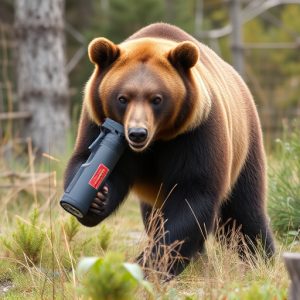Maximizing Bear Repellent Spray Lifespan: Ingredient Insights & Application Tips
Bear spray is a vital safety measure for outdoor enthusiasts in bear country. While it typically has…….
Bear spray is a vital safety measure for outdoor enthusiasts in bear country. While it typically has a long shelf life, the active ingredients can degrade over time, reducing its effectiveness. Regularly checking expiration dates and understanding the ingredient composition ensure optimal protection during bear encounters. Storing it properly and maintaining good condition are crucial to guarantee its potency when needed most.
“Enhance your camping experience and ensure maximum safety with this comprehensive guide to bear repellent spray. Discover why it’s an essential tool for any outdoor enthusiast, especially in regions inhabited by bears. Learn about the crucial factor of understanding bear spray expiry dates and what ingredients to look for in effective repellents. From decoding product labels to mastering application techniques and storage tips, we equip you with knowledge to make informed choices, ensuring your trips are both enjoyable and secure.”
- Understanding Bear Spray Expiry Dates: What You Need to Know
- Decoding the Ingredients in Bear Repellent Sprays
- Effective Use and Application Techniques for Maximum Protection
- Storage and Maintenance Tips to Ensure Longevity
Understanding Bear Spray Expiry Dates: What You Need to Know
Understanding Bear Spray Expiry Dates is crucial for anyone planning a camping trip in bear country. Bear repellent spray, while effective, does have an expiry date and understanding this is essential to ensure its potency when needed. Most quality bear sprays are designed with a shelf life of several years, but the active ingredients can degrade over time, reducing their effectiveness.
The expiry date is usually indicated on the packaging and should be checked before each trip. Bear spray formulations vary, and some may have different expiration periods. Ingredients like capsaicin or chili oil, which are key to their effectiveness, can lose potency after a certain time. Regularly checking and replacing your bear repellent spray is vital for maintaining its integrity, ensuring you’re well-prepared should you encounter a bear during your outdoor adventures.
Decoding the Ingredients in Bear Repellent Sprays
When it comes to decoding the ingredients in bear repellent sprays, understanding what’s inside is crucial for an effective and safe camping experience. Many popular brands use a combination of capsaicin, a substance derived from chili peppers, and synthetic or natural pyrethrins, which are insecticides. These components work together to deter bears by creating an unpleasant sensory experience—the peppery sting and the insect-repelling chemicals.
Bear spray ingredients also include various solvents and propellants like butane or propane, ensuring the mixture is effectively dispensed. Some products may have additional elements like ultraviolet light reflectants to enhance visibility in emergency situations. Regularly checking expiration dates on bear repellent sprays is essential, as these products can degrade over time due to oxidation and loss of potency. Knowing the ingredients and keeping an eye on their quality will help ensure your safety during outdoor adventures.
Effective Use and Application Techniques for Maximum Protection
Bear repellent spray is a crucial addition to your camping essentials, offering maximum protection against unexpected encounters with bears. To ensure its effectiveness, proper use and application techniques are essential. Firstly, always check the expiration date of your bear spray; ingredients can degrade over time, so using an expired product may be less potent. Secondly, familiarize yourself with the recommended application distance and spray pattern. Aim for a wide, even misting at close range (around 20-30 feet) to ensure thorough coverage of your body, especially your head, neck, and shoulders – areas bears are likely to target.
Avoid spraying in windy conditions or towards fire as these can disperse the spray too widely or blow it back onto you. When faced with a bear, stay calm, raise your arms to make yourself appear larger, and speak firmly. If the bear doesn’t retreat, use your spray following the training you’ve received. Aim for the bear’s face and eyes, creating a barrier of mist between you and the animal. Remember, practice makes perfect; train regularly with a partner in varying scenarios to ensure you’re prepared should an actual encounter occur.
Storage and Maintenance Tips to Ensure Longevity
Proper storage and regular maintenance are key to keeping your bear repellent spray in top condition. Store it in a cool, dry place, away from direct sunlight and heat sources, as extreme temperatures can affect its performance. Keep it sealed tightly and out of reach of children and pets. Check the label for any specific storage instructions regarding ingredients like capsicum or other active substances.
Regularly inspect your bear spray for any signs of damage, corrosion, or leakage. Ensure the nozzle is free from obstructions and that the spray pattern remains consistent. Follow manufacturer guidelines for maintenance, which may include shaking the can periodically to ensure the ingredients remain mixed. Replace the spray if it shows any signs of deterioration or if you notice a significant drop in pressure, as an expired or low-pressure bear repellent might not provide adequate protection.
When it comes to bear repellent spray, understanding its expiry dates, ingredients, proper usage, and storage is crucial for effective camping protection. By decoding these key aspects, you can ensure maximum longevity and reliability, making your outdoor adventures safer and more enjoyable. Remember, knowing the specifics around bear spray—including when it does expire—is an essential part of preparing for potential encounters in the wild.


